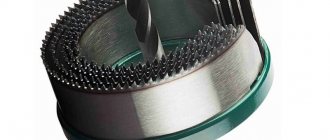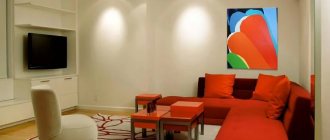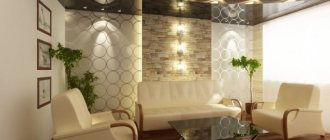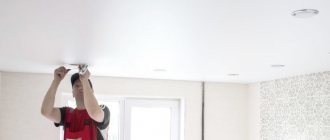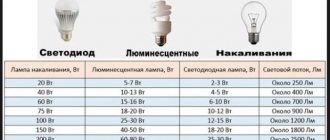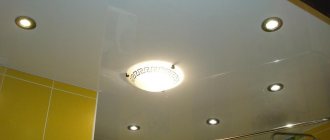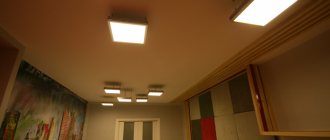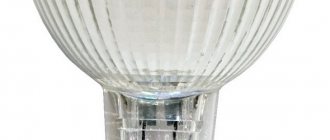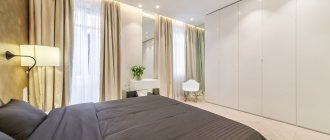Energy-saving lamps and LED devices are replacing conventional incandescent lamps. The latter are economical to use. Installing lighting for an apartment or house using such lamps is not difficult, but you need to know a number of nuances when choosing.
LED spotlights will help create the right atmosphere in your home. Unlike ordinary chandeliers, they will hide the shortcomings of the room and emphasize the advantages thanks to the possibility of “light zoning”.
Application of spotlights
Ceiling diode LED lamps are devices for arranging lighting for objects for various purposes. They are widely used in private housing, shops and shopping centers, cafes, bars, restaurants, administrative buildings, exhibitions, and workshops. No less often, spot light is used to create billboards and signs.
At home, such lighting is perfect for any room - kitchen, bathroom, living room, bedroom, office. You can create local illuminated areas on the wall and floor, stairs, and interior items. Lamps serve as a decorative element; they are widely used to implement bold design solutions. Thus, spotlights can provide basic and additional lighting.
Diode lighting devices consist of two important parts:
- semiconductor LED;
- driver (power supply) for current conversion.
The lamps provide high-quality light of different spectrums (depending on the type of semiconductor) without ripples or blinking. This eliminates harm to the human eye even with constant use.
Tightness
Spotlights are sealed and open. The former should be used in bathrooms, saunas, and other places with high humidity; for these rooms we recommend choosing a model with a stainless base and durable glass that will not burst under the influence of steam and temperature changes. Non-sealed ones can be used absolutely everywhere, except in rooms with high humidity or open spaces.
It should be noted that decorative spotlights cannot be used in production conditions and explosion and fire hazardous areas.
Advantages and disadvantages of lamps
LEDs for spotlights are mounted under a special plastic housing (diffuser). Their advantage is the ability to choose the type of glow - warm (yellow) or cold (white). Cold light is considered the best, close to natural daylight. LED devices are also produced that can create red, green, blue, yellow light, which other types of lamps cannot do. This allows you to decorate the room in an original way and implement design ideas.
Other advantages of diode lamps are:
- low energy consumption - an opportunity to seriously save on electricity costs (power is only 3.5 W/hour);
- fast switching on - no period of lamp “burning up”, good flow of light;
- safety for humans, including children - the composition does not contain mercury or other harmful substances, diodes do not emit ultraviolet radiation;
- the ability to use at any network voltage (220 V transformer converts into the required 1.5-3.5 V);
- long service life - up to 10,000 hours, unlike other types of lamps;
- no heating of the light bulb and adjacent surfaces during operation;
- light weight of the lamp, easy installation.
Unlike fluorescent energy-saving light bulbs, diode light bulbs are not sensitive to voltage changes. They will not deteriorate even if there is a jump to 60 V, since a voltage converter is included in the electrical circuit. Diodes are 17 times more economical than fluorescent ones, because the energy consumption of the latter is 60 W/hour. Diode lamps can be thrown into trash containers, while fluorescent lamps require special disposal conditions due to the presence of mercury.
Are there any disadvantages to LED spotlights? The only disadvantage that can be noted is the high cost of the devices. Although when analyzing the price/quality ratio, they are undoubtedly the best.
What is a halogen lamp
This is a special device for lighting rooms, working on the same principle as standard power lamps. Halogen light bulbs consist of a base, an incandescent filament, and a sealed bulb filled with gas. The atoms of the gaseous active substance react with the evaporating tungsten wire and are immediately decomposed under the influence of high temperature. This prevents the evaporated metal from settling on the walls of the flask. The advantage of such lamps is their extended service life.
Device
There are several types of capsule halogen light bulbs, which differ in the size of the bulb, its shape, and the presence of special reflectors. They are united by the typical structure of the base, the chemical composition of the gas mixture, and the presence of tungsten wire, which provides the glow. Halogen lamps for spotlights and industrial lanterns can differ in voltage: they work equally effectively from networks of 220, 380 V and miniature sources of electricity 6-100 V. The brightness of the lighting is easily adjusted with a switch with a rheostat.
Principle of operation
The main difference from traditional lamps is the constant halogen-tungsten filament self-healing process. When heated, the wire slowly evaporates, like an incandescent light bulb. The gas inside the flask reacts with the metal atoms, trapping them and preventing them from settling on the walls. The peculiarity of the resulting compounds is the impossibility of their existence at high temperatures, so a decomposition reaction occurs with the subsequent deposition of tungsten atoms back onto the filament. When the power is reduced by the rheostat, the temperature drops and self-healing stops.
Life time
The glow temperature constantly maintains the filament relatively intact due to the self-healing of tungsten by halogens. This increases service life. The process is not ideal: the metal settles unevenly on the surface of the wire, and thin areas gradually form. The average service life of the device is 6000-7000 hours of continuous operation. Smooth switching through a rheostat increases it to 8000-12000 hours.
Advantages and disadvantages
Halogen lighting devices have a number of advantages and disadvantages arising from the characteristics of the internal structure, operating principle, and operational capabilities. The advantages include:
- Long service life.
- Stable operation, continuous luminous flux.
- Increased efficiency compared to standard incandescent lamps.
- Durability, resistance to mechanical damage.
- Small sizes.
- Reduced levels of ultraviolet radiation.
The disadvantages of this type of lighting include:
- Fire hazard due to heating the flask to high temperatures. Before testing the halogen lamp with a tester, let it cool.
- The gas mixture used in lamps is poisonous to humans.
- Unusual white lighting color.
LED lamps for spotlights
There are different types of light bulbs used in ceiling lamps, but LEDs are the most cost-effective. It is important to choose them correctly. If for fluorescent lamps the power determines the intensity of the glow, then for diodes the number of watts consumed is not the determining parameter. For this type of device, the ratio of power and brightness is different.
A 60-watt incandescent lamp produces the same brightness as an 8-watt LED device. The same diode is equivalent in brightness to a 35-watt halogen light bulb. Therefore, for the convenience of calculations, there is a lumen - a unit of measurement of the “power/brightness” proportion.
| Diode lamp power, watt | Luminous flux, lumen |
| 2-3 | 250 |
| 4-5 | 400 |
| 6-10 | 400 |
| 10-12 | 900 |
| 12-15 | 1200 |
| 18-20 | 1800 |
| 25-30 | 2500 |
When purchasing, you need to consider the number of hours that the lamp will last. The figure is indicated on the packaging and is 7000-10000 hours. The fewer voltage drops and on-off switching the LED is exposed to, the longer it will last. To use diode lighting outdoors during the dark period of the day, purchase special lamps with protection against damage. When purchasing a lamp separately from the luminaire, it is important to consider the sizes and types of base and socket. Some devices are mounted using contacts in the lamp body.
Types of lamps
There are various types of spot lighting devices on sale, differing in a number of indicators. Based on the type of fastening, they are divided into overhead, suspended, and built-in.
Invoices
Such lamps are also called external lamps; they are applied directly to the surface. It is better to use them on frameless bases - a concrete ceiling, a brick wall, but the devices are also suitable for plasterboard and suspended ceilings. They are indispensable if you need to decorate a room without changing the dimensions of the space or carrying out major repairs.
The design of the surface-mounted lamp is as follows: the diffuser body is located on the mounting platform. The mounting strip is installed above a hole smaller than that of the body itself (otherwise it will not be covered by the lampshade). A grounding cable is connected to the strip, the housing is fixed with side screws after the wires are joined.
Built-in
Lamps can be built in on frame bases - plasterboard structures, panel walls, slats, on furniture partitions, in wall niches, suspended ceilings. Built-in lamps are also called mortise lamps. They are used on the floor, stairs, bar counters.
A special feature of the devices is a housing with built-in lamp clamps and special fasteners. The claws open when installing the lampshade; no reinforcement is required. The product must be mounted in a pre-cut hole in accordance with the markings of the wires. Typically, the sizes of such lamps are compact, so to create basic lighting you will have to buy more of them.
Hanging
The pendant lamp has 2 bodies - one that is mounted at a certain distance from the surface and a socket sitting at the base. The cases are connected by a decorated power cable. There is a hook for hanging from the ceiling. You can use both overhead and built-in pendant devices.
Such lamps can be mounted on any type of base; they can serve as a source of lighting and a decorative component. Fastening elements are included, but too massive products need to be reinforced with mounting strips.
Design Features
In addition to the main elements, the spotlight has a radiator - it is responsible for cooling the structure. Since the remaining parts (diodes, diffuser) are in contact with the radiator, thermal paste is applied between them to improve contact. When installing, it is important to ensure that there is free space around the radiator (otherwise the lamp will burn out). The design of spot LED devices is also different.
Rotary
Rotating devices are used for directional lighting; the angle of light supply is smoothly adjusted in them. The lamp has a body and a moving part with a lamp. The rotation angle is 30-40 degrees, it allows you to highlight any space with light. Since the mobility of the product implies faster wear of parts, it is recommended to strengthen the fastening points during installation. Among the rotating devices there are the following types:
- rotary-retractable - not only change the angle of inclination, but also extend outward;
- Spots are plastic lamps, manually adjustable, and have a different number of shades on one common fastener.
Static
Non-rotating (static) models do not allow you to adjust the angle of inclination. Once installed, they only shine in one direction, usually down or forward.
How to change an LED light bulb in a precision lighting fixture
Lighting fixtures of various types can be built-in. Built-in spots can be single or point. Such lights with LEDs are installed on brackets, with the help of which directional lighting is created. It is impossible to disassemble such a structure yourself in order to remove the LEDs without preparation. Along with the light bulb, you always have to remove part of the lamp itself.
Important! The LED lamp is always replaced with a part of the lamp.
There are spotlights with a housing designed for a specific type of LED lamp, and with a special element for installing the LED. To remove the light bulb itself, you will need to disassemble the lamp in both cases.
LED light bulbs are designed to last a long time. Their installation is usually carried out together with recessed lamps. They will operate for 20 years. If the need arises to replace them, then you should contact a professional. The LEDs can be replaced by the qualified electricians who installed them. They will select the correct power devices, dismantle lighting structures, replace light bulbs and reassemble built-in lighting fixtures. This approach will help save time and money.
Selection options
Spot lighting elements are selected taking into account design requirements, room features, and surface type. The simpler the design, the easier it is to keep the device clean. It is better to buy simple products for the kitchen, because they will get grease, splashes, and will have to be washed frequently. For suspended ceilings, it is worth purchasing round lamps to eliminate the risk of damage to the base.
Design
The variety of “appearance” of diode lamps is great. You can choose exactly those that are ideal in shape, color, texture, material. More often, stores offer square and round devices; there are devices in the shape of a triangle, rectangle, and asymmetrical ones. The lamps can be recessed or protruding, and in the latter case the angle of supply of the light flux is greater. Materials for the manufacture of diode lamps - metal, plastic, glass, plaster. Products are painted to look like metal, there are white, black, multi-colored and with patterns.
Types of cartridge
All lamps have sockets, the lamp is screwed into them. Each cartridge has its own base. They are marked with special symbols so that you can choose the lamp that matches the socket. The 1st letter of the marking reflects the type of base, the 2nd – the subtype, the 3rd – the number of contacts. Here are the main types of lamp bases:
- B – pin;
- E – with thread;
- P – focusing;
- G – pin;
- S – soffit.
The number after the letter indicates the distance between the pins. Threaded and pin sockets are more often sold; they are easier to use.
Brightness level
When purchasing diode lamps, take into account the parameters important for high-quality lighting. These are luminous flux, diffuser type, color temperature. The last indicator in Kelvin is of three types:
- 2500-3000 K (warm white) – candle color;
- 3000-4200 K (white) – dawn/sunset;
- more than 4500 K (cold white) – moonlight.
The higher the Kelvin number, the cooler and brighter the light. It is better to buy lamps with an average reading of 3000-3500 K. Too bright light is harmful to the eyes with constant use. When considering brightness levels, pay attention to the type of diffuser. It can be matte or transparent. The first gives a uniform distribution of light flux, but causes intensity losses (up to 30%). For large areas, it is better to buy diodes with transparent diffusers.
Another important indicator of brightness is luminous flux. It is determined by the type and quality of LED matrices. When purchasing warm light bulbs, the rated power is 30% higher than that of cold light bulbs.
Degree of protection
In the instructions for the lamp there is a letter designation IP - it reflects the degree of protection of the product. Two numbers are indicated:
- first: from 0 to 5 – protection against solid pollutants;
- second: from 0 to 8 – protection from moisture.
The lower both numbers, the lower the degree of protection of the model. For example, the first number (1-4) means that particles from 50 to 1 mm in size (in descending order) will not get inside the housing. The “5” marking confirms protection against even the finest dust. The second number (8) means the device is protected from complete immersion in water; it can be installed outdoors.
Types of halogen lamps for home
The range of halogen lamps is very wide: from low-voltage lamps to large floodlights that can illuminate a stadium. Home light bulbs are available in three varieties:
- With external flask. Standard halogen chandelier bulbs. External protection prevents the scattering of fragments and the spread of gas after breaking.
- With reflector. Designed to create a source of directional light. Used in car headlights and flashlights.
- Capsule. Miniature light bulbs that are used in luminaires not protected by glass.
Linear
The device provides bright illumination of a large area without leaving dark corners, and additional UV protection makes the light bulb safe. It is recommended to install in large warehouse areas:
- Model name: J 500W Camelion 2937;
- price: 64 RUR;
- characteristics: linear capsule, power 500 W, voltage 220 V, base type R7s, luminous flux 9000 lm;
- pros: bright, clean white light, quartz bulb reduces the amount of ultraviolet radiation;
- cons: rare type of base.
An excellent example of an uninterrupted source of external lighting for streets, building facades, roads, and private sector areas. Remember that models of this power are a fire hazard if installed incorrectly:
- Model name: HALOLINE 64740 1000W J189 Osram;
- price: 540 rub;
- characteristics: tubular linear capsule, power 1000 W, voltage 220 V, base R7s, luminous flux 22000 lm;
- advantages: long radiation propagation range;
- cons: high color temperature 3000 K.
With outer box
The second capsule, installed in front of the main one, guarantees safety if the light bulb burns out. The protective flask will prevent the gas from spreading and debris from scattering around the room:
- Model name: Uniel E27 42 W;
- price: 70 rub;
- characteristics: spherical protective capsule, power 42 W, voltage 220 V, luminous flux 670 lm, base E27;
- pros: matte capsule;
- Cons: gets very hot outside.
The model exceeds standard incandescent lamps in efficiency by 30-40% with a total increase in radiation level. Save on energy costs by using halogen from Electrostand:
- model name: Electrostand E14 42W;
- price: 35 rub;
- characteristics: pear-shaped capsule, 42 W, 220 V, luminous flux 630 Lm, E14 base;
- advantages: low temperature;
- cons: not found.
- How to treat pyelonephritis
- What are the most effective lozenges for a sore throat?
- 1st trimester screening - interpretation of results. Biochemical blood screening and ultrasound examination of a pregnant woman
Capsule
Small dimensions combined with a high level of light emission make the model an ideal choice of lighting fixture for jewelry stands. Install several of these side by side and you will be able to see the smallest flaws on the product:
- model name: JC 20W Camelion g4 12V 1955;
- price: 35 rub;
- characteristics: low-voltage capsule, 12 V, 20 W, luminous flux 320 Lm, G4 diode base;
- pros: powerful lighting;
- cons: not found.
The device is manufactured as a point light source for suspended and suspended ceilings. Install small built-in lamps at a distance of 80-100 cm - and the room will always be well lit:
- model name: SVETOZAR SV-44762-M;
- price: 30 rub;
- characteristics: power 20 W, voltage 12 V, luminous flux 266 lm, warm white, yellow;
- pros: small size;
- cons: service life 2000 hours.
With reflector
A light bulb that emits a narrow beam of light of high brightness is ideal for the role of a lighting element for a headlight or flashlight. Low power consumption will prevent you from being left without light at the wrong time:
- Model name: COSMOS MR16 35W GU5.3 12V FMWc LKsmMR1612V35W;
- price: 50 rub;
- characteristics: power 35 W, voltage 12 V, bulb MR16, service life 2000 hours;
- pros: excellent lighting power 525 lm;
- cons: not found.
Blocks of such illuminators are installed in spotlights. It would also be a good idea to mount these lamps in the ceiling to create a network of powerful spotlights:
- model name: SVETOZAR SV-44733;
- price: 60 rub;
- characteristics: 35 W, 12 V, light power 652 lm, soffit capsule, GU5.3 base;
- pros: good focusing of the light beam;
- cons: overheats.
Low voltage
The powerful stream of light that such a small device generates puts the model at the top of the list of the best flashlight lighting elements. Install one of these - and no darkness is scary:
- model name: Navigator 94 204 MR16 50W 12V 2000h;
- price: 70 rub;
- characteristics: 50 W, 12 V, warm white light (3300 K), GU5.3 base;
- pros: high brightness;
- cons: energy consumption, thread wear resistance.
COSMOS lamps with increased lighting brightness are often installed on external store signs, under glass display cases of stands. The 750 lux light source is guaranteed to attract attention:
- model name: COSMOS JC 50W G6.35 12V LKsmJC12V50W;
- price: 35 rub;
- characteristics: 50 W, 12 V, JC bulb, G6.35 base;
- pros: light power 750 lm;
- Cons: fragile contacts.
Calculation of the number of lamps to illuminate a room
There is a simple formula that allows you to calculate the number of lighting fixtures:
N = (S * W) / P, where:
- S – room area;
- W – specific power of light flux (standard, taken from the reference book);
- P – power of 1 lamp.
On ceilings, it is better to install lighting fixtures symmetrically, evenly over the entire area, which will eliminate shading of individual zones. It is important to make indents of 60-80 cm from the walls, more if there is furniture. The dimensions of the lamps are also taken into account - large ones are placed no closer than 1.6-1.8 m to each other.
Lamp layout diagrams
Designers offer a number of classic ceiling lighting schemes using LED devices:
- oval;
- rectangular;
- square;
- round with a central element;
- two semicircles;
- in the form of a cross;
- along the perimeter of the room;
- waves;
- an arc with a center.
First you need to draw a layout diagram on paper. The chandelier is hung in the center or in the middle of the work area. These schemes can be combined to create unusual options. In the corridor it is better to mount the lamps in a line or in pairs. For convenience, the kitchen space is zoned in the form of circles, ovals, and arcs. Waves of dotted luminous elements look attractive in the bedroom. The best option for a child’s room is original designs made from lamps. In the bathroom, lights are usually installed around the perimeter and in the center.
With the help of LED lighting devices, you can easily organize the main and additional lighting. It is important to take into account all the parameters in order to buy suitable devices, then they will last a long time and trouble-free.
